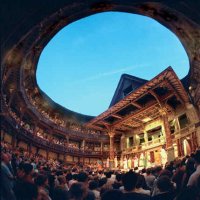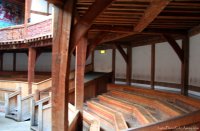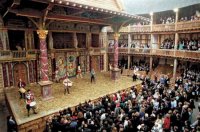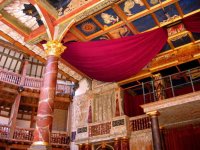William Shakespeare is regarded as one of the greatest English writers of all time and one of the world’s most famous playwrights. His surviving work includes 38 plays and 154 sonnets and his plays have been translated into every known language. It is compulsory in the UK for school children from 11-16 years old to study at least 2 Shakespeare plays at school. Therefore, Shakespeare and his plays and sonnets are part of English culture, imbedded into our education from a young age.
![JPEG - 40.3 Kb]()
- The globe theatre London
However, as Shakespeare’s plays are written and still studied in the old English language it is very difficult for any normal 11-16 year old to understand. When I learnt Shakespeare at school as a teenager, it was, quite frankly, mind-numbingly boring. The language the Shakespeare plays were written in made absolutely no sense to me, I felt as though I was reading a play written in a completely different language. I did not understand the words I was reading from Romeo & Juliet, or the purpose of identifying “iambic pentameters” when I couldn’t understand the plot or the dialogue between the characters. All I knew was that it was written by Shakespeare, one of the greatest English playwrights of all time, and I had to learn it!
The moment that Shakespeare suddenly came alive for me was when I first watched Romeo & Juliet performed as a play. A group of actors came to our school and performed Romeo & Juliet and conducted a workshop afterwards, where we participated in role-plays. We explored what might have been going through Mercutio’s mind when he was dying or how Juliet would have felt when she thought that Romeo was dead. By putting Shakespeare’s plays into context like this and watching the plays how they were originally intended to be seen, as a play in a theatre, it transformed my understanding of Shakespeare and at that point I began to understand and finally appreciate the “great bard”.

- the open roof of the Globe
For this reason I strongly believe that the best place to appreciate Shakespeare is in the theatre. You may not understand every word and forget that “thee” or “thou” means “you”, but you will certainly follow the main plot through the overall performance. You cannot escape Mercutio’s anger, Romeo & Juliet’s naivety or the families’ s anguish and despair at their loss as a result of their feuding. All of this is conveyed clearly through the play, even if you don’t understand every single word that is spoken.
Without doubt the best performance of a Shakespeare play I have ever seen is at “Shakespeare’s Globe” in London, a modern reconstruction of the original Globe Theatre which opened in 1997.

- Seats at the Globe.
The original Globe Theatre in London, where Shakespeare’s plays were originally performed, was built in 1599 by Shakespeare’s playing company, the “Lord Chamberlain’s men”. The theatre was owned by actors who were also shareholders in Lord Chamberlain’s men, including William Shakespeare. The theatre was subsequently destroyed by fire on 29 June 1613 when a theatrical cannon, which was set off during a performance of Henry VIII, misfired and ignited the wooden beams and thatching. No one was hurt except a man whose burning breeches were put out with a bottle of ale. The theatre was rebuilt in the following year, but like all other theatres in London after the English Civil War the Puritans closed it down in 1642. In 1644 the theatre was pulled down to make way for tenements.
The modern reconstructed Shakespeare’s Globe theatre (the “Globe”) was founded by the American actor and director Sam Wanamaker.The Globe seeks to further the experience and international understanding of Shakespeare in performance. The theatre is dedicated to providing an international resource to the exploration of Shakespeare’s work and the playhouse for which he wrote, through the connected means of performance and education.
The Globe has facilities for students, teachers and academics which they can use as a resource from all over the world. Shakespeare’s Globe provides educational programmes and publishes material for students at all levels.

- Inside the Globe
The Globe receives no annual government subsidy and it is self-financing. Activities are therefore balanced in such a way that net income from the exhibition, box office and donations is sufficient to cover costs spent on educational and academic work.
To watch a Shakespeare play in the style it was originally intended and in the reconstructed Globe is the best way to appreciate and fully understand Shakespeare. The Globe even has standing room tickets available in the pit (which cost around £5 each) where in the sixteenth century spectators would drink beer and heckle the actors. The style of the performances really do bring Shakespeare’s plays to life and excellently communicate the comedy, the tragedy, the music and the dancing that sixteenth century spectators would have enjoyed. However, I would strongly recommend paying extra to sit in the covered stalls (prices start from around £20 each). Some Shakespeare plays can last for over 3 hours, which is a long time to stand and you run the risk of experiencing the famous English rain in the open air standing area.

- The old Globe Theatre
Shakespeare should be an experience for everyone to enjoy and understand today at all ages, from teenagers to adults. If you visit Shakespeare’s Globe, I have no doubt that you will fully experience and enjoy Shakespeare at his best, how he originally intended his work to be enjoyed, through performance.